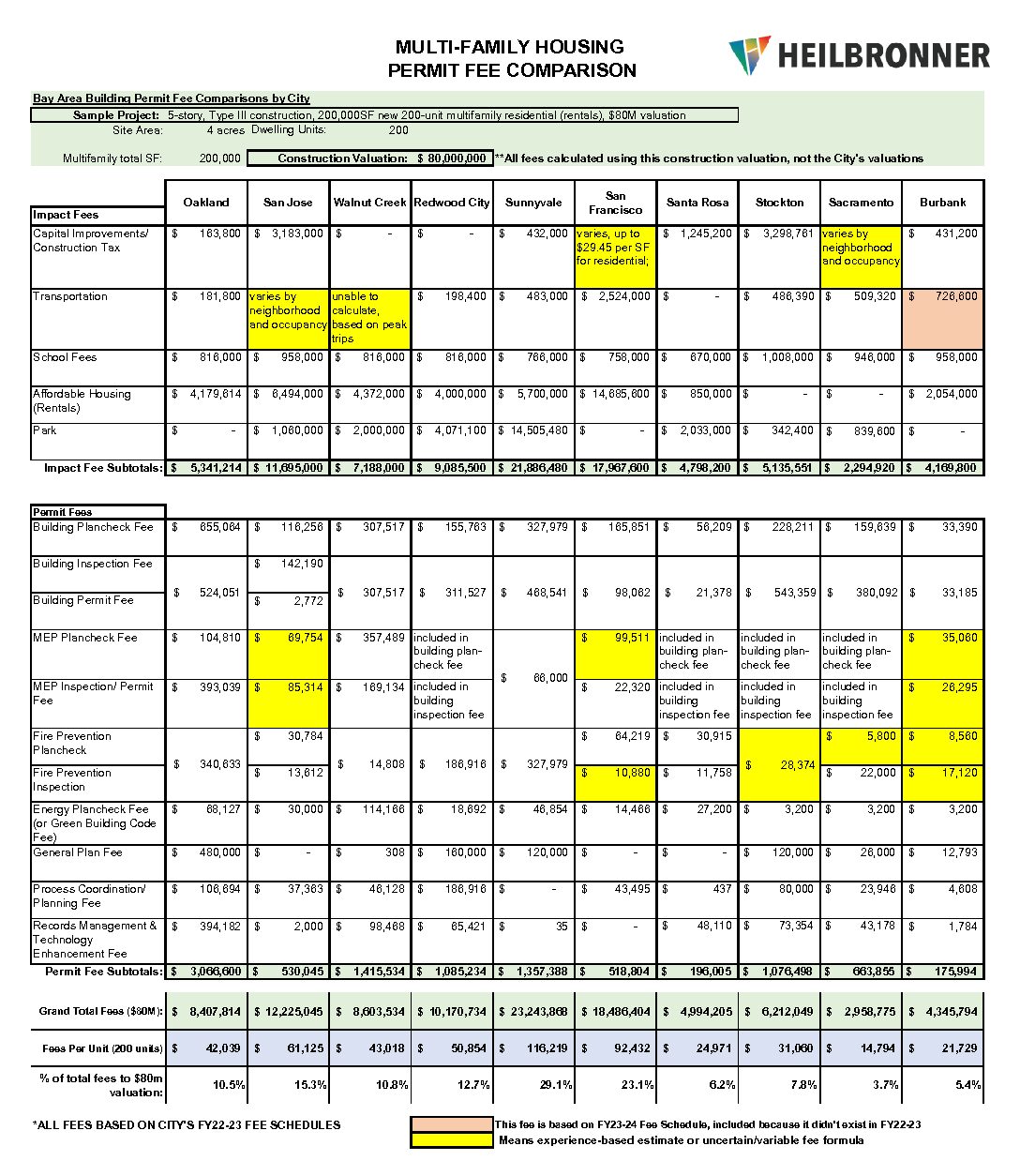This is the second in a series of 3 analyses comparing development “Impact Fees” and Building Permit-related fees between 10 California cities from around the state where we’ve currently or recently had projects. The first study used a new warehouse build as the prototype project, and the final study will use a commercial tenant improvement project as the basis for the fee comparison.
Heilbronner AM will prepare an Agency Fee Schedule that provides estimates for all entitlement, permit and other agency fees – tailored specifically to your project regardless of location. Contact Us if you’re interested in obtaining an agency fee estimate for your development.
Multi-family Housing Project Fees
The need for housing in California is a hot topic, particularly when it comes to affordability. It’s shocking to see the agencies’ costs that add to “unaffordability” – whether they are market rate or affordable units. It’s more shocking when adding costs for the entitlement and permit processes that bring discretionary requirements (more costs) and a time lag that adds more costs again. The cherry on top is high interest rates suffered by the developers and the resulting costs that get passed on to renters and buyers alike.
Our second comparative fee study is based on a new multi-family project. Depending on location, fees range from $2.96M to $23.24M on the same design parameters for an $80M housing project. This equates to between $14,794 and $116K+ per unit in fees, depending on jurisdiction.
Method for the Comparison
The fee comparison uses a prototype project as a basis for its fee calculations, in this case a 5-story, Type III construction, 200,000 SF multi-family housing project with 200 rental units and an $80M valuation, as described in the graphic below.
With each of our studies the specific fee categories chosen are based on the most common types of agency fees found consistently in cities across the state. The fees included are not a complete representation of the fees applied to a project in any given city, but we aimed to include the most prominent fees in the ‘impact fee’ and ‘building permit’-related fee categories. Fees relating to entitlements, other departments, utilities, or agencies may be addressed in future fee studies.
The fee comparison is not perfect, but it should be representative of how much individual fees can differ between municipalities for the same project, assuming the same valuation.
Construction Valuations are Not Uniform Across Jurisdictions
For the uninitiated, Impact Fees and Building Permit fees (and their relatives in other departments) are generally based on the project’s Construction Valuation and Occupiable Floor Area (excluding spaces like parking garages, and storage – in some cases), or a combination thereof. For a prototype project comparison like this, Floor Area is a constant regardless of jurisdiction, but the same is not the case when it comes to Construction Valuation. It is not common for every city to use the same (or even similar) construction valuation formula, even if all other categorical inputs (occupancy, building type, floor area) are the same.
For a more detailed discussion of the jurisdictional variation in Construction Valuations, see our Building Permit Fee Comparison #1 – New Warehouse.
Additional Notes regarding the Fee Study
*For this multi-family project fee study, please note that all fees are based on a presumption that all units are market-rate units. We understand that this is somewhat unrealistic in today’s political/cultural climate, but incorporating a percentage of affordable housing units significantly complicates the fee calculations and credits issued against impact fees for affordable housing can vary significantly between cities. For this purpose, this study is based only on market-rate units, but it can be fairly assumed that in most or all jurisdictions inclusion of affordable units will reduce the impact fees for a project.
This comparison is based on FY22-23 fee schedules obtained from the represented cities, except for the Burbank Transportation Impact Fee which is based on a FY23-24 fee, but is included here for comparative purposes as it did not exist in FY22-23.
All estimates are based on the best information available at the time, and in some instances, past experience.
Many cities, especially larger cities, also have other significant fees that apply to specific/area plans or other geographically defined ‘assessment districts.’ In cities where these regional fees are not applied to all property within city boundaries, or have high variance between neighborhoods, the fees were excluded as they would not fairly represent the cities for comparative purposes.
Further details regarding the methods used for the comparison may be provided upon request.
A version of this comparison was also issued with our Newsletter on 9/1/2023, to be added to our mailing list contact us, or sign up Here.


